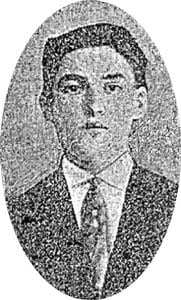Mr Thomas Joseph McCormack was born in Glenmore, Ballinamuck, Co Longford, Ireland on 12 December 1892.1
He was the son of Bernard McCormack (b. 1843), a farmer, and Maria McKenna (b. 1842)(2) who were married around 1871. They went on to have nine children, four of whom survived infancy, and Thomas' known siblings were: Hugh (b. 1872), John (b. 1877) and Catherine (b. 1887).
The 1901 census shows Thomas and his family living at house 17 in Glenmore, Ballinamuck in a household headed by his 90-year-old grandfather Hugh McCormack. By the time of the 1911 census his father ran the farm and his brother John, who was married with his own children, was living and working there also. Thomas and his sister Catherine were absent, they already having emigrated to the USA (he in 1910), living in Bayonne, New Jersey where Thomas worked as a bartender and lived at 38 West 20th Street. He returned home to Ireland for a visit in early 1912.
To return to America McCormack boarded the Titanic at Queenstown as a third class passenger (ticket number 367228 which cost £7, 15s). He was travelling with several others from Co Longford, including the Murphy sisters, the McCoy siblings and his cousins John and Philip Kiernan.
At the time of the collision, McCormack was asleep in his cabin when his cousins awoke him. He dressed and hurried from his cabin with the Kiernans but got separated from them in the crowds. By his own account, he made for the open decks and jumped into the water, striking out for a lifeboat and managing to cling onto the gunwale of the craft before being repelled by sailors using their oars, sustaining bruising to his head. He eventually managed to haul himself into a lifeboat, reportedly with the help of the Murphy sisters.
Thomas M'Cormick, who is in the
hospital suffering from wounds in the
head, declares that he jumped when the
ship was sinking. He got his hands on
the gunwale of a lifeboat, but members
of the crew struck him on the head and
tore his hands loose. After repeated ef-
forts, he swam to another boat, and had
the same reception. Finally two sisters
(Mary and Kate Murphy) pulled him
aboard, despite the efforts of the crew.Examiner (Launceston, Tasmania) 23 April, 1912
His brother-in-law Bernard Evers (the husband of his sister Catherine) journeyed to New York to meet him coming off the Carpathia; in the confusion, the two missed each other and Evers spent the rest of the night and next day searching for him before discovering he was at Ellis Island. They were then reunited and returned to Bayonne.
Thomas naturalised as a US citizen in 1916 and ran his own pub in Bayonne for twenty years before working as a security guard. He was twice married, firstly to Johanna "Hannah" Nugent, née Barry3 (b. 1871), a widow almost two decades his senior.
Hannah had been born in Ireland, the daughter of Robert Barry and Catherine Haggerty. She had left her birthplace in 1889 and settled in Bayonne where she married in 1895 4 to Jeremiah Nugent (b. 1865), a tavern keeper. With him, she had five children: Patrick (b. 1898), Jeremiah (b. 1899), Mary (b. 1902), Nora/Anna (b. 1906) and Robert (b. 1909). When Nugent died is not clear.
By 1920 Thomas, Hannah and her family are at 376 Boulevard in Bayonne. Two years later he attended the Bayonne Memorial Day parade and returned home in foul form and lashed out at his 14-year old stepson Robert Nugent, throwing a milk bottle at him and inflicting a large slice on his head. His wife complained to the police and he was arrested and charged with assault.
His second marriage was to Mary Ellen Donovan (b. 15 November 1893), the niece-by-marriage of his first wife.5 They had no children and he became a widower in 1962. He was still giving interviews up until the year before his death despite having been bed-ridden for several years.
Thomas spent his final days living at the John F. Kennedy Arms on 70 Westfield Avenue, Elizabeth, New Jersey. He died there on 4 November 1975 aged 83 and was buried in Holy Name Cemetery, Jersey City with his second wife.

Comment and discuss
-
Does anyone know the maiden name of Thomas McCormack's wife? Two of my sisters knew him and are unaware that he was ever married. He indicated to my sister that he was single - this was near the end of his life.
-
Ed, Her maiden name was Mary Donovan and she died March 24, 1962--is buried beside Thomas. I hope this helps. Phil
-
Thanks Phil - it does help. Any idea of where she was from? Could it be Aughnacliff, Co. Longford where he was from?
-
Ed, sorry that I don't know--haven't investigated her at all. Thomas McCormack has two great-nephews that I'm in touch with and I'll ask them and let you know. Regards, Phil Gowan
Open Thread Leave a Reply